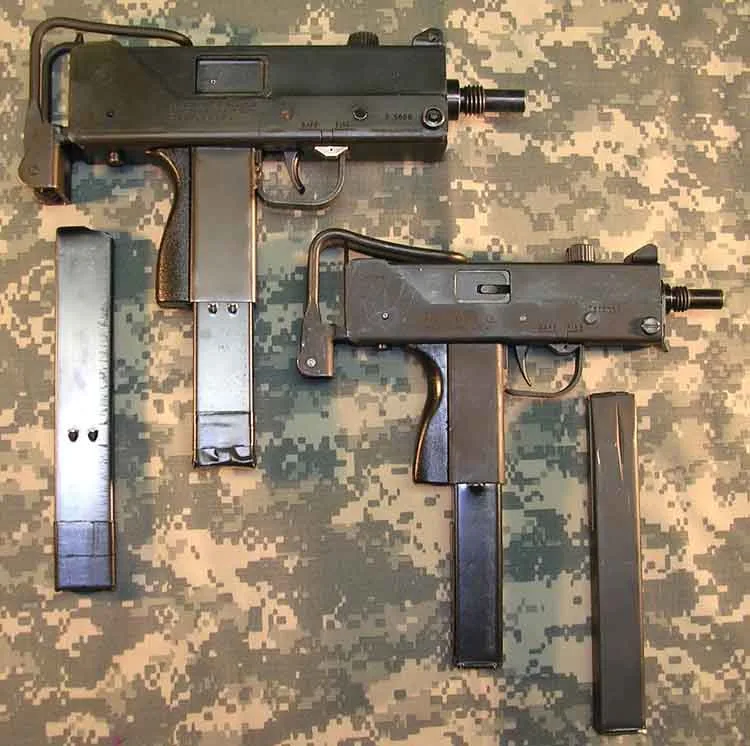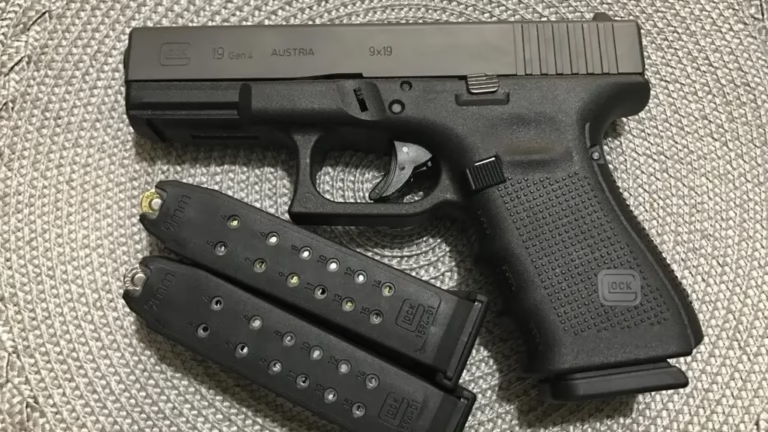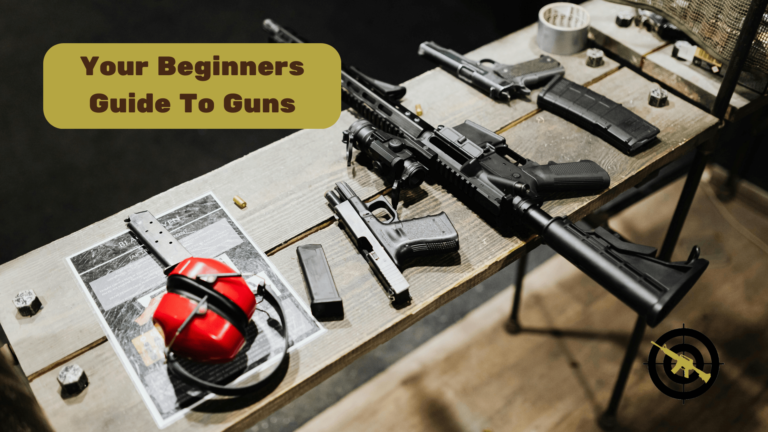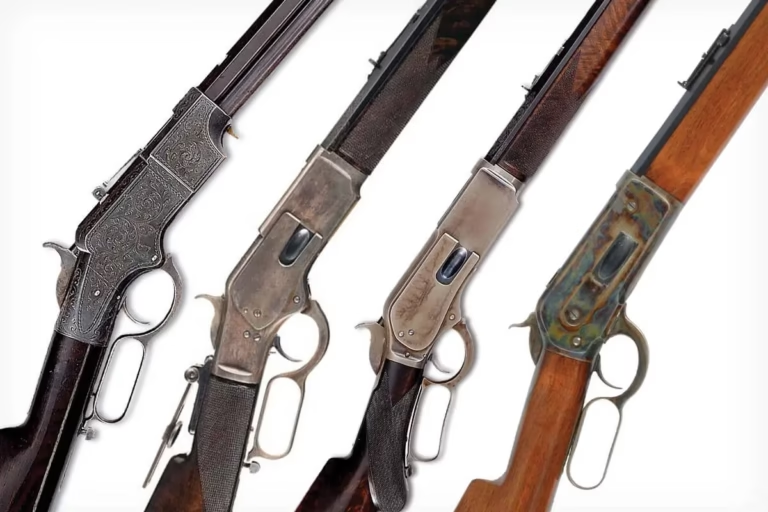The MAC-10 is the larger, heavier, and more powerful parent design, while the MAC-11 is its smaller, faster, and more frantic offspring. Understanding their differences in caliber, size, and handling is key to appreciating the unique design and historical place of each of these iconic firearms.
We have a full review of the Mac-10 that you can check out.
Introduction
The MAC 10 vs MAC 11 are two of the most recognizable machine pistols in the world, often seen as icons of 1980s action films and video games. Designed by Gordon B. Ingram, these firearms share a similar, boxy aesthetic that can make them difficult to tell apart at a glance. However, despite their family resemblance, they are fundamentally different in performance, handling, and purpose. This guide will provide a detailed MAC 10 vs MAC 11 comparison, breaking down their specifications, history, and key distinctions to help you understand what truly sets them apart.
A Shared Heritage The Ingram Legacy
Before diving into the differences, it’s important to understand the shared lineage of the MAC-10 and MAC-11. Both were developed in the 1960s by American engineer Gordon B. Ingram and later produced by the Military Armament Corporation (MAC). Ingram’s design goal was to create a compact, simple, and inexpensive submachine gun.
A key innovation in both models was the telescoping bolt. This design, inspired by earlier Czech models, wraps around the barrel when in battery. This allows for a much shorter overall weapon length without sacrificing barrel length, contributing to their signature compact profile. Both firearms are straight blowback operated, built from stamped sheet metal to keep production costs low, and feature a rudimentary wire-frame stock. Their similarities are intentional, but their differences are what define their unique roles and reputations.
At a Glance Specification Comparison
To begin our MAC 10 vs MAC 11 analysis, a side-by-side look at the technical data reveals the core distinctions immediately. While specifications can vary slightly between manufacturers and production runs, these are the generally accepted figures for the original MAC models.
MAC-10 (Model 10)
1. Caliber: .45 ACP or 9x19mm
2. Rate of Fire: Approx. 1,090 rounds per minute (.45 ACP)
3. Barrel Length: 5.7 inches
4. Overall Length (stock collapsed): 10.7 inches
5. Weight (unloaded): 6.26 lbs
6. Magazine Capacity: 30 rounds (.45 ACP) or 32 rounds (9mm)
MAC-11 (Model 11)
1. Caliber: .380 ACP
2. Rate of Fire: Approx. 1,200 rounds per minute
3. Barrel Length: 5.1 inches
4. Overall Length (stock collapsed): 9.8 inches
5. Weight (unloaded): 3.5 lbs
6. Magazine Capacity: 16 or 32 rounds
Key Differences Explored In Detail
The spec sheet gives us the numbers, but the real story of the MAC-10 vs MAC-11 battle is in how those numbers translate to real-world handling and performance.
Caliber and Firepower
The most significant difference lies in the ammunition. The MAC-10 was designed as a true submachine gun, chambered in the powerful .45 ACP and 9x19mm pistol cartridges. These rounds provided substantial stopping power, making it a viable, albeit difficult to control, close-quarters weapon.
The MAC-11, on the other hand, is chambered in the much smaller .380 ACP cartridge. This round is significantly less powerful, placing the MAC-11 firmly in the machine pistol category rather than the submachine gun class. The choice of .380 ACP was a direct trade-off to achieve a smaller, lighter firearm.
Size and Weight
The MAC-11 is noticeably smaller and lighter than its older sibling. It is essentially a scaled-down version of the MAC-10, designed for maximum compactness. The MAC-10, while compact for a submachine gun of its era, is still a hefty piece of hardware at over six pounds unloaded. The MAC-11 weighs nearly half that, making it much easier to carry and conceal. This size difference is the primary visual cue for distinguishing between the two models.

Rate of Fire and Controllability
Both weapons are famous for their incredibly high rates of fire, but the MAC-11 takes it to an extreme. Firing at around 1,200 rounds per minute, it can empty a 32-round magazine in under two seconds. This blistering speed, combined with its lightweight frame and the snappy recoil of a blowback action, makes the MAC-11 notoriously difficult to control. It is often described as a “bullet hose” that is more suited for area suppression than precise shots.
The MAC-10 is slightly slower at around 1,090 RPM but is still a handful. The heavier .45 ACP version produces significant recoil. While the added weight helps absorb some of that recoil, keeping the weapon on target during a sustained burst remains a challenge for even experienced shooters.
Cultural Impact and Legacy
No MAC 10 vs MAC 11 discussion is complete without acknowledging their place in pop culture. The MAC-10, with its intimidating look and sound, became a Hollywood staple for villains and action heroes in the 1970s and 80s, appearing in films like “Escape from New York” and “Pulp Fiction.” Its blocky silhouette is instantly recognizable.
The MAC-11, while also appearing in media, carried a slightly different reputation. Its extreme rate of fire and smaller size made it a symbol of chaotic, overwhelming firepower in movies and video games. Both firearms cemented an image of compact, no-frills firepower that continues to influence firearm design and media portrayals today.
Which Is Better For a Collector
For enthusiasts and collectors of historical firearms, the choice between an M10 and an M11 depends on personal interest. The MAC-10 is arguably the more iconic of the two. As the original design chambered in more substantial calibers, it represents the primary vision for Ingram’s compact submachine gun. It has a greater historical footprint and is more widely recognized.
The MAC-11 appeals to those interested in the engineering challenge of miniaturization. It represents the logical extreme of Ingram’s design philosophy: making the smallest possible machine pistol. For collectors, its unique handling characteristics and staggering rate of fire make it a fascinating piece of firearms history. Parts and magazines for both can be found, but the 9mm and .45 ACP variants of the MAC-10 generally have better aftermarket support.
Final Verdict
So, in the MAC 10 vs MAC 11 debate, which one comes out on top? The answer is neither. They were designed for different purposes. The MAC-10 is a true submachine gun, built to deliver major pistol caliber rounds in a compact package. The MAC-11 is a machine pistol, prioritizing size and concealability above all else, sacrificing power to achieve its tiny footprint.
The MAC-10 is the larger, heavier, and more powerful parent design, while the MAC-11 is its smaller, faster, and more frantic offspring. Understanding their differences in caliber, size, and handling is key to appreciating the unique design and historical place of each of these iconic firearms.
Now that you know the difference between the MAC-10 and MAC-11, explore our other firearm comparison guides to expand your knowledge.





